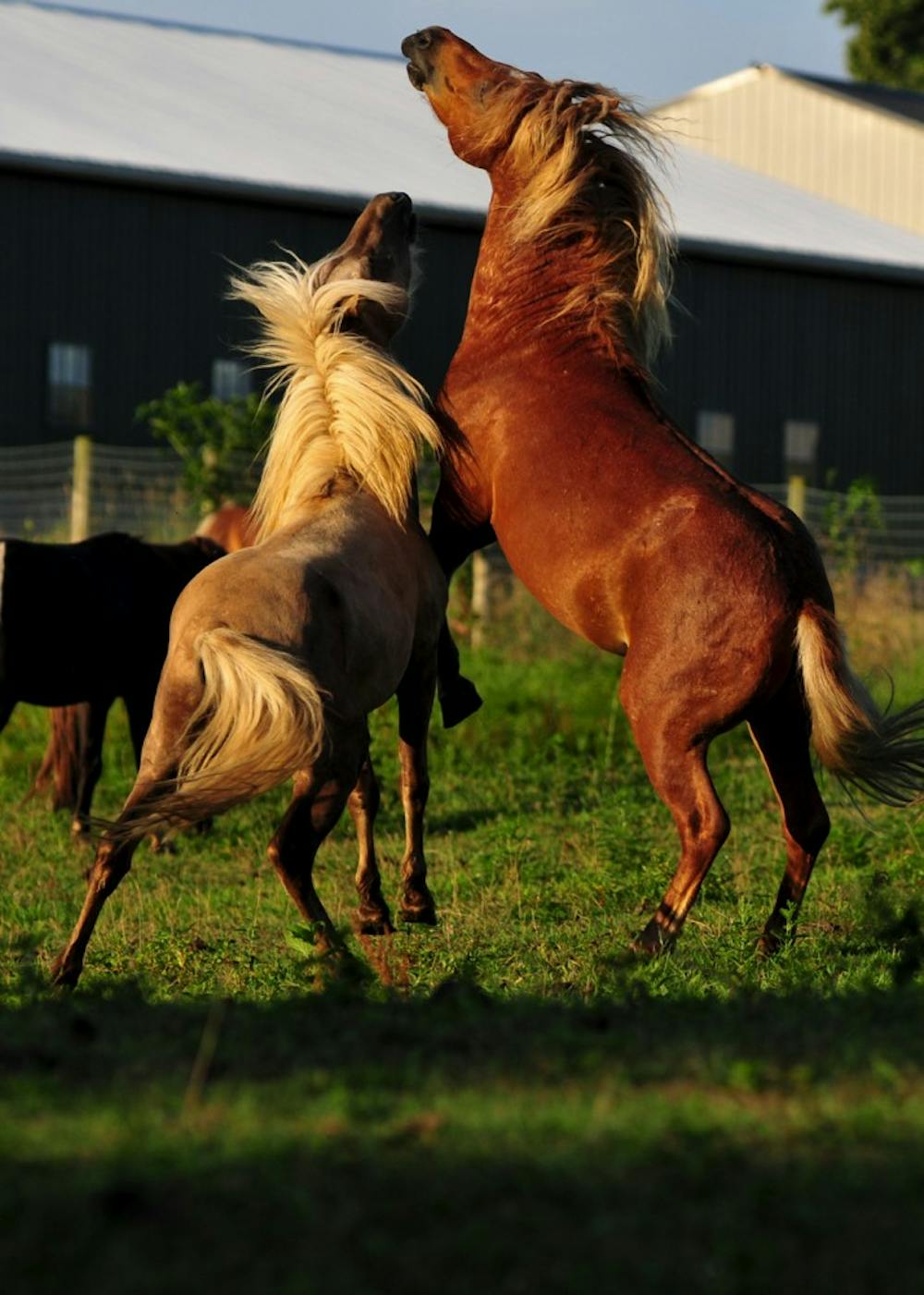
Two horses play in the fields at New Bolton Center, part of Penn’s School of Veterinary Medicine.
Credit: Courtesy of Penn School of Veterinary MedicineAbout 45 minutes away from the heart of campus sits something that is unique to Penn’s School of Veterinary Medicine — a large herd of semi-feral horses.
Since the 1980s, veterinary students have had access to observe and study horses through the school’s New Bolton Center located in Chester County.
In 1994, the center launched the Equine Behavior Program, which is today one of only a few horse behavior programs in the country.
The center’s 700 acres are home to about 90 ponies — all of which are part of one of the largest horse behavior research programs in the world, according to Sue McDonnell, founder and head of the Equine Behavior Program.
Since its launch, the program has been expanding rapidly.
While the program’s early work was focused on reproductive and breeding behavior, it has since grown into a full-service veterinary program focused on the study of horses in their natural social setting, McDonnell said.
Today, all veterinary students are required to take courses at the New Bolton Center before earning their degree.
“Having an equine behavior program here at Penn allows students to learn the fundamentals of equine behavior and then some techniques to affect equine behavior so that they can be safe and effective veterinarians,” assistant professor of medicine at the New Bolton Center Rose Nolen-Walston said.
Apart from a few preventative measures like necessary health care, the horses at the center are left to live as they would in natural conditions without human interference.
Though the Equine Behavior Program was meant only to be a short-term project, McDonnell is pleased that the school has stuck with it.
“It is a great living laboratory for students to see how horses interact under normal social situations, meaning that they’re out there and we don’t interfere with anything,” McDonnell said.
For third-year veterinary student Candice Lorandeau, having the opportunity to research with the program helped her learn the best ways for veterinarians to interact with larger animals.
“We have been able to learn a lot from the semi-feral herd,” she wrote in an email. “We spent hours working with ponies to help them get comfortable with being handled and learn behaviors that would make it easier for us to work with them.”
Veterinary student Jennifer Vlasaty Alvarez agreed, writing in an email that the program is “a must for anyone considering going into equine, large animal or behavioral medicine.”
“It gives you the opportunity to be exposed to things … that you may not have had much experience with in the past, and in a low-stress environment that is beneficial for all involved,” she wrote. “How better to understand an animal … than to experience it in its natural setting?”
She added that McDonnell has 24/7 access to the horses, which can help address some problems that may appear behavioral, but are in fact medical.
Students also have access to the New Bolton Center outside the realm of the classroom.
“There also is quite a lot of research that students can participate in,” Nolen-Walston said. “It’s an opportunity to interact with equine research for the first time and to be able to either participate in or even perform small research projects.”
However, McDonnell said the program does have its limitations. Every year, it must send some horses away because it does not have the space to accommodate them.
“We have to remove animals because we only have so much space and they are very fertile, so we need to take animals out each year and re-home them,” McDonnell said. “It’s a sad meeting when we have to sit down and decide who has to leave.”
Looking forward, though, McDonnell said the herd’s success bodes well for the future of the New Bolton Center and the Equine Behavior Program.
“I hope that it will continue long after my tenure here,” she said. “For some time, we will try to continue to maintain a herd of some form because it is so valuable to take people out to see how horses interact.”
Nolen-Walston added that the horses continue to provide students, professors and researchers unique insight into the meaning behind their behavior.
“Because horses can’t speak, any time you evaluate a horse for a problem, you’re always looking at the behavior,” Nolen-Walston said. “Having that resource here is just a remarkable resource to allow us to evaluate our patients more accurately and thoroughly.”
The Daily Pennsylvanian is an independent, student-run newspaper. Please consider making a donation to support the coverage that shapes the University. Your generosity ensures a future of strong journalism at Penn.
DonatePlease note All comments are eligible for publication in The Daily Pennsylvanian.





